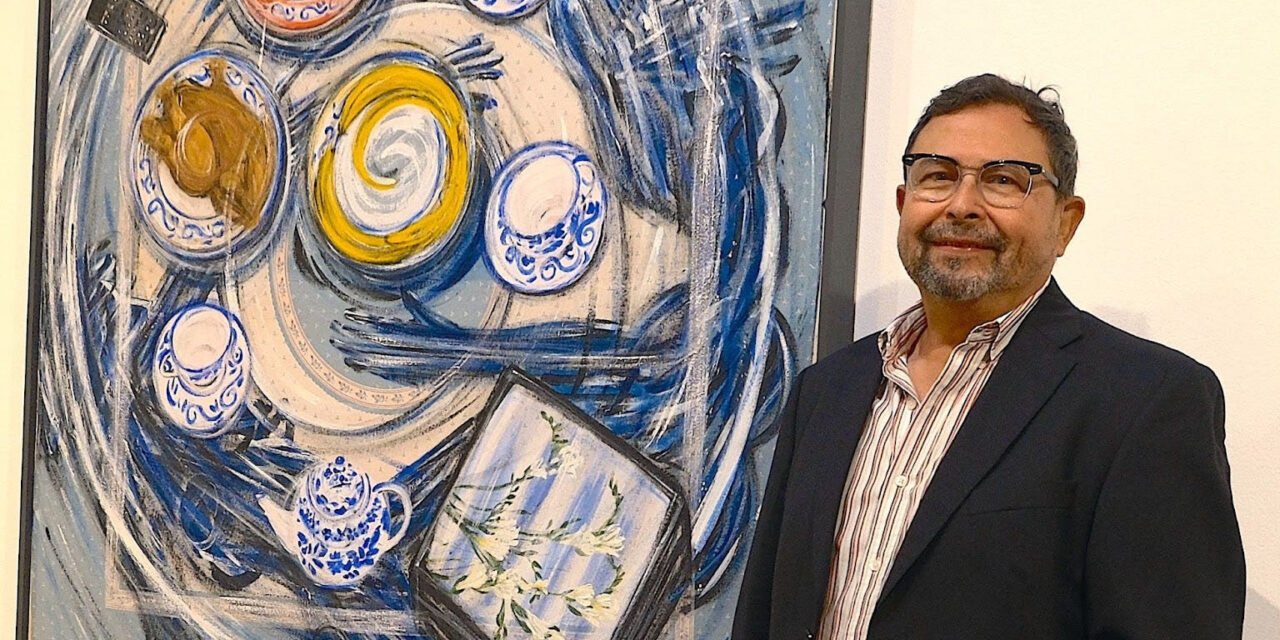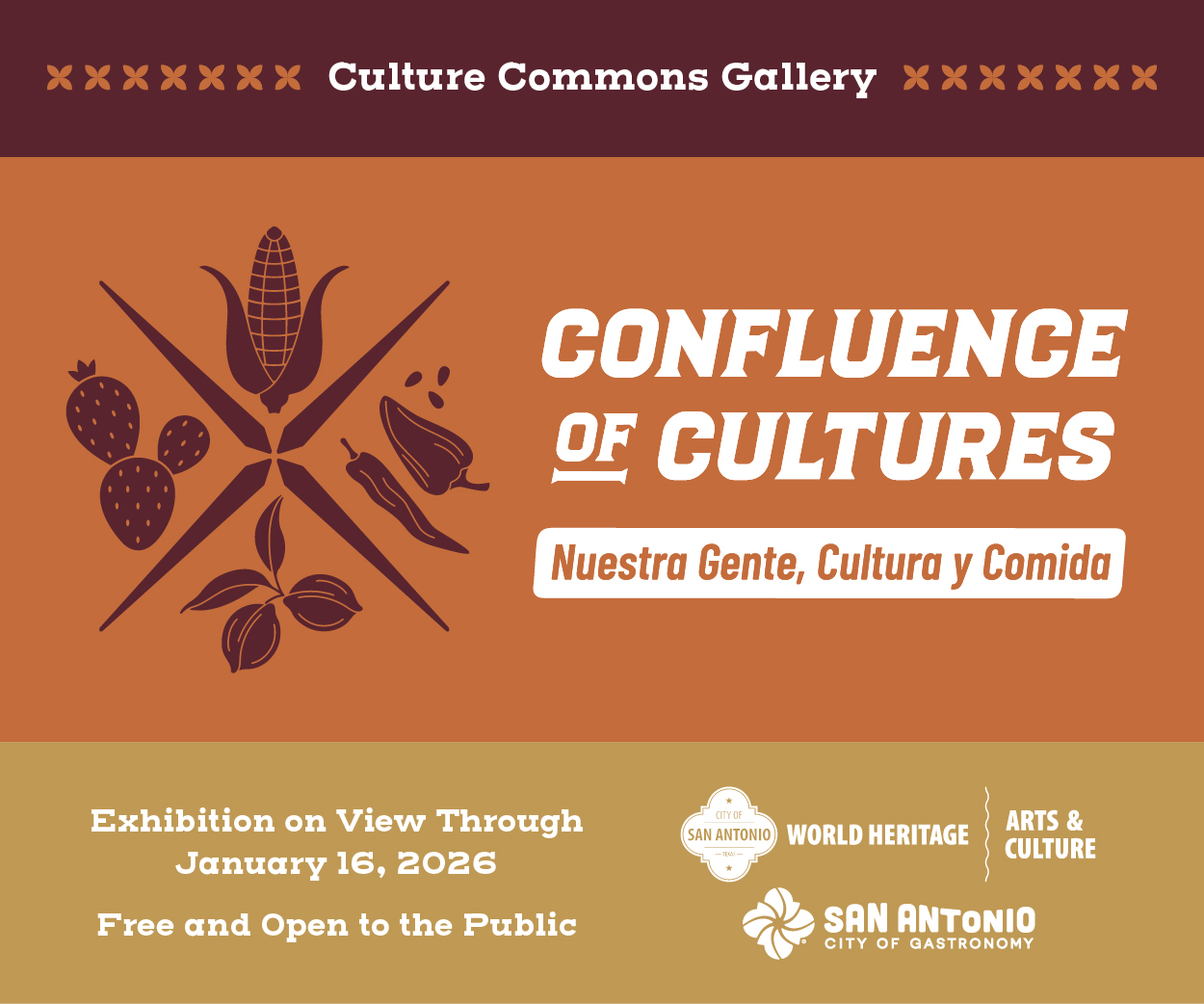Seventy-five stunning drawings, lithographs, screenprints, paintings, photographs, and sculptures dazzle viewers in the “Dining with Rolando Briseño” exhibit at the Centro de Artes Gallery. These works, curated by Dr. Ruben C. Cordova, represent a half-century of artistic production by a true connoisseur of Mexican and Mexican American art and culture.
The majority of Briseño’s works in the Retrospective draw upon his conceptual construction of “tablescapes,” an artistic embodiment of a meeting place that ritualizes how we eat and live. Art curator Gracie Cavnar noted that Briseño “uses the table as a setting to manipulate images
that project a microcosm of humanity.” Like an artist’s canvas, the table to Briseño “is probably one of the purest forms of human expression.”
Jack Morgan of NPR described many of Briseño’s pieces in this new Centro show as “depicting tabletops, but each has a kinetic energy about them that makes the elements seem to revolve or pop off the canvas.” Two favorites of mine, “Discussion at the Table” and “American Fighter,” were featured in Hispanic Art in the United States: Thirty Contemporary Painters and Sculptors, a major exhibit organized in 1987 by the Museum of Fine Arts, Houston, Texas. Rolando Briseño was one of five Texans and the youngest selected for the exhibit of 30 U.S. Latino artists.
John Philip Santos, Briseño’s longtime friend, observed, “Rolando’s work has always been focused on the primal space on the table, the meeting place of family,
ancestors, friends, boxers, and lovers.” Santos first met Briseño in the early 1980s while writing a story about him for the San Antonio Express-News. When Santos moved to New York in the late 1980s, he visited Briseño frequently at his Lower East Side New York art studio.
Briseño’s introduction to art came at an early age. The Briseño family maintained connections with Mexican relatives and went annually to Mexico City and several northern Mexican cities for family visits. As a young boy in the 1950s, Briseño marveled at the public art in Mexico’s large cities, especially in Mexico City where several marvelous murals by the great Mexican artists Diego Rivera, Jose Clemente Orozco, and David Alfaro Siqueiros could be found. In grade school, he went across town to the Witte Museum for weekend art classes. Upon graduation in 1970 from Central Catholic High School, Briseño went to Mexico City over the summer to learn more about Latin American art at the National Mexican University [UNAM]. Briseño also studied with Fernando de Szyzslo at the La Pontificia Universidad Catholic de Peru.
The edited book by Dr. Norma E. Cantu, Moctezuma’s Table: Rolando Briseño’s Mexican and Chicano Tablescapes, is an excellent primer for appreciating this artist’s work. The book includes essays by John Philip
Santos, Amalia Mesa-Baines, Jacinto Quito Quirarte, Ruben C. Cordova, and Sandra Cisneros. In Moctezuma’s Table, Chicana artist Amalia Mesa Bains commented on what she called Briseño’s “Re-historization of Mexican and Chicano Culture” writing, “For over twenty years Rolando Briseño has been pursuing themes related to the table and food as representations of a life source. The works transform the materials of everyday life by integrating the metaphor of food as a cultural and political phenomenon.”
In the fall of 1971, Briseño moved to New York City to study at The Cooper Union for the Advancement of Science and Art on a full scholarship. While in New York, he participated in a NYC artists’ apprenticeship program and met Latino artist Pedro Lujan, a native of El Paso who had arrived in New York in the mid-1960s. Lujan’s friend, Luis Jimenez, another well-known Chicano artist, also lived and painted in the city and the Latino artists encouraged one another’s work.
Briseño stayed one year in New York and returned to Texas to enroll in the Art Department at the University of Texas at Austin. While living in Austin, he joined the Con Safo art group and participated in his first Chicano show, a Con Safo exhibit in 1975 at the San Antonio Institute of Texan Cultures with the title, “La Movida: A Creative Perspective of Contemporary Humanities Iconography.” He graduated from UT Austin with a Bachelor of Arts degree and a Bachelor’s degree in Fine Arts.
Briseño moved back to New York in 1977 to study for a Master’s degree in Fine Arts at Columbia University. Tragically, he suffered a major setback to the start of his art career. The building where he had his apartment and studio burned down. All of his artwork was destroyed in the fire. If not for that devastating fire that destroyed fifty paintings in his apartment and studio in New York City in 1985, there would be 125 pieces of art in this marvelous show.
After the disastrous fire, Briseño moved to Rome, Italy where the Wessel O’Connor Art Gallery began showing his work. The following year, he received a Rockefeller Foundation Fellowship to study art at the prestigious Bellagio Center in Italy. In Italy, he began to focus on the importance of the “cultural dinner table.” He explained, “The dinner table became a spiritual place to meet with friends, make deals, and talk.” During his time in Italy, he also decided to paint dinner table scenes on original tablecloths.
Some of Briseño’s large and exceptional works could not be exhibited at the Centro De Artes. Over the past two
decades, Briseño’s commissions have included a 300-foot mural for the Austin Convention Center, a 130-foot painting for Houston International Airport, and 5,000 pounds of bronze sculptures at Trinity University.
Five years ago Rolando Briseño paused his art career to provide home care for his life-long partner, Angel Rodriguez-Diaz. In New York during the mid-1990s,
Briseño met Rodriguez-Diaz and convinced him to move to San Antonio. They bought an old grocery store building and restored the site as a highly successful art studio.
Briseño is currently archiving his work and that of Rodriguez-Diaz. Both of these talented artists have left an important legacy in San Antonio and in Latino art. Briseño’s work can be seen in the UTSA collection which I initiated; on the Trinity University campus; at the Houston Intercontinental Airport; at the Austin Convention Center; the Corcoran Gallery of Art, Washington D.C.; the Museo de Barrio, New York; the Brooklyn Museum of Art; the Blanton Museum of Art at UT Austin; the Romo Collection at St. Philip’s College; and in several private collections in Europe and Latin America.
Rolando Briseño: A 50-Year Retrospective at the San Antonio Centro de Artes Gallery.






